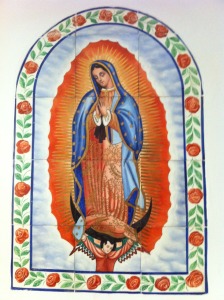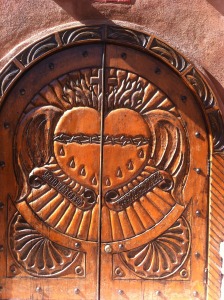Santa Fe zen – #1: the way of holy faith
When on the road to see Our Lady of Guadalupe, you will come by many turns to Santa Fe. Roughly translated, “Santa Fe” means “city of holy faith.” The Guadalupana is Santa Fe’s gentle patron saint, a vision of kindness and mercy whose call from the hills, according to the legend, sang like the voices of many sweet birds, down to the listening ears of the peasant Juan Diego passing below:
“Let not your heart be disturbed. Do not fear….”
The mountains of Colorado drop back as you travel south, and the expanding vistas of northern New Mexico beckon. Beyond those guiding peaks, the road begins to meander. And so do I.
 At the border sits Conejos, the only county seat in the state that’s not an actual incorporated town, population 58, total area less than half a square mile.
At the border sits Conejos, the only county seat in the state that’s not an actual incorporated town, population 58, total area less than half a square mile.
But here, Nuestra Señora de Guadalupe, Our Lady of Guadalupe Catholic Church, watches over the long San Luis Valley. The brick version is from 1948, but originally, in 1858, Our Lady raised picket walls, called jacal, around the valley faithful.
“Are you not under my protection? Are you not happily within my fold?”
 Our Lady of Guadalupe is beloved here, found again and again all along the way from Conejos to Santa Fe. Her story was published in the Nahuatl/Aztec language in 1649. The text is called the Nican Mopohua, “Here It Is Told.” It tells a story from 1531, blending Aztec, Chichimecan Indian, and Christian beliefs, wrapping ancient imagery of the Sun God and the Earth Mother in the new mysticism of Catholicism. In the story, Our Lady asks Juan Diego to build her a church on the holy hill; in this part of the country, she has been given many shrines, many hills to call home.
Our Lady of Guadalupe is beloved here, found again and again all along the way from Conejos to Santa Fe. Her story was published in the Nahuatl/Aztec language in 1649. The text is called the Nican Mopohua, “Here It Is Told.” It tells a story from 1531, blending Aztec, Chichimecan Indian, and Christian beliefs, wrapping ancient imagery of the Sun God and the Earth Mother in the new mysticism of Catholicism. In the story, Our Lady asks Juan Diego to build her a church on the holy hill; in this part of the country, she has been given many shrines, many hills to call home.
I am a peregrina, a pilgrim rolling south past the graceful arc of New Mexico’s earthen gatepost, San Antonio Mountain. I think of the hill of Tepeyac, where the apparition of “the ever-virgin Holy Mary, Mother of God” called affectionately to “Juanito,” asking him,
“Am I not here, who is your Mother?”
New Mexico is a feminine landscape. The hills are softer, green and gold of rounded desert chamisa, that sweet-smelling rabbitbrush, the evergreen piñon, and turquoise sage. Mesas stretch slowly across the horizon, indistinct as the last moments of dreaming upon waking, clouds continually forming far across immense valleys over distant, fading hills.
“Let not your heart be disturbed.”
The highway is leading toward Upaya Zen Center. In Sanskrit, upaya is “skillful means,” using wisdom and compassion in our interactions with others to help them grow toward enlightenment. Medios hábil: interesting that in Spanish, being able means being skillful, not just having the potential capacity to do something. You don’t just talk a good game – you get it done. The Spanish translation feels more Zen than the Sanskrit. Not a hope, but a direct statement. Not intention, but training.
 The words may sound direct, but this is New Mexico…where walls and buildings, earth and sky, all curve. So I curve, too, down a slight detour, the winding road to Chimayo. It has been almost 20 years since I have seen this small adobe chapel, and after many U-turns and missed signs, I am not completely sure I am yet on the right road. Passing tiny, dilapidated houses, dirt yards fenced in chainlink, and gardens of chiles and squash behind jacal pickets, I pull into the ubiquitous Family Dollar store parking lot, just behind a local couple getting out of a 20-year-old green Toyota. I roll down my window. “May I ask you a question? Is this the road to Chimayo?”
The words may sound direct, but this is New Mexico…where walls and buildings, earth and sky, all curve. So I curve, too, down a slight detour, the winding road to Chimayo. It has been almost 20 years since I have seen this small adobe chapel, and after many U-turns and missed signs, I am not completely sure I am yet on the right road. Passing tiny, dilapidated houses, dirt yards fenced in chainlink, and gardens of chiles and squash behind jacal pickets, I pull into the ubiquitous Family Dollar store parking lot, just behind a local couple getting out of a 20-year-old green Toyota. I roll down my window. “May I ask you a question? Is this the road to Chimayo?”
Chimayo reminds me of the word chimera, “something that exists only in imagination and is not possible in reality.” I feel like I’m asking if this is the road to magic and miracles. I think of the story of Juan Diego and Our Lady on the Hill: Juanito is just this regular guy who heard beautiful birdsong coming from the hilltop and decided to turn from the main road and wander up to see what magic this might be. Following the winding way itself became his miracle.
The name Chimayo actually derives from a Tewa Indian name for the hill of Tsi Mayoh, one of four sacred hills marking the four sacred directions. The soil itself was believed to have healing powers by the Tewa, who called it “blessed earth,” and this belief was picked up by Spanish settlers in the 1600s who founded the village of Chimayo on the ruin of a Tewa pueblo. In 1814, the source for digging the blessed earth, El Posito, was contained within a small church built to honor El Señor de Esquipulas, the Black Christ worshipped in Guatemala credited with healing abilities. Medios hábil. Maybe this was skillful means. Layer upon layer, like a laying on of hands, these centuries of beliefs in miraculous healing. All circling around this sacred opening in the earth.
The grey-haired husband is coming around the car, smiling.
“The, uh, chapel?” I ask again.
“Santuario? Santuario de Chimayo?”
“Yes – santuario! Is this the road?” I am given specific instructions, to pass the ranchos, to look for a man’s small service station and turn there.
The woman, older than me but ageless in her grace, smiles slowly, then broadly. “This – is Chimayo.” She raises her arms as she smiles, her hands lifting palms up to the sky. “All this, all…is…Chimayo!”
 Santuario. I am seeking sanctuary, at the same time I am seeking the skills to better offer compassion and help in the world. Our Lady of Family Dollar is so wise; all this, all this is in fact the sacred hill we climb, our Tsi Mayoh, our Tepeyac, seeking the voice of the Great Mother who sings like birds, and the warmth of the Sun God on our faces, seeking the high holy place, and the deep source of healing.
Santuario. I am seeking sanctuary, at the same time I am seeking the skills to better offer compassion and help in the world. Our Lady of Family Dollar is so wise; all this, all this is in fact the sacred hill we climb, our Tsi Mayoh, our Tepeyac, seeking the voice of the Great Mother who sings like birds, and the warmth of the Sun God on our faces, seeking the high holy place, and the deep source of healing.
“Am I not your health? Do not fear that sickness, nor any other sickness or anguish.”
 She is here as well, at Santuario de Chimayo. The Guadalupana. She is everywhere here on the rolling road to the city of holy faith…so many names, so many layers, so many incarnations.
She is here as well, at Santuario de Chimayo. The Guadalupana. She is everywhere here on the rolling road to the city of holy faith…so many names, so many layers, so many incarnations.
 I wind my way back toward Española, then south. In Santa Fe, I take the Paseo de Peralta, curving into yet more quiet hills. I have traveled to Upaya to remember the meaning of the zendo, the holy place of practicing the stillness of the hills to quiet our noisy minds, the temple named Dokanji – Circle of the Way. Circulo del Camino. So many words, so many voices, in so many languages.
I wind my way back toward Española, then south. In Santa Fe, I take the Paseo de Peralta, curving into yet more quiet hills. I have traveled to Upaya to remember the meaning of the zendo, the holy place of practicing the stillness of the hills to quiet our noisy minds, the temple named Dokanji – Circle of the Way. Circulo del Camino. So many words, so many voices, in so many languages.
Here in the forgiving spaciousness of New Mexico, I can feel that I am just a small pilgrim, hoping to make some progress on the way. And the way is winding, circular, spiral. Like the petals of the roses Our Lady gave to Juan Diego as proof of his honest heart.
Unseen birds are twittering in the cooling twilight as I arrive. I listen carefully. Because Juan Diego listened and took the curving path up the hill, he found The Lady. By following the call of beauty and meaning, the true magic, we learn that the most skillful means can be to meander among the miracles.
“What else do you wish? Do not grieve nor be disturbed by anything.”








